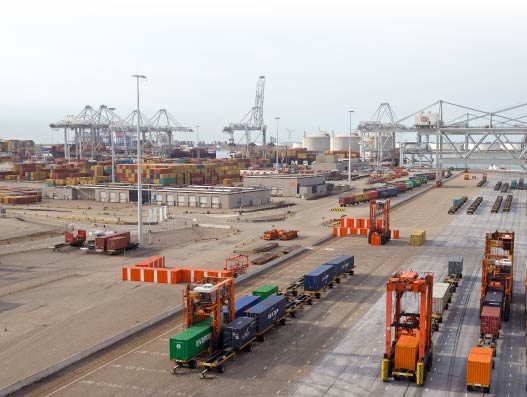
Port of Rotterdam In pursuit of innovation
The Port of Rotterdam is a stronghold for innovation and is keen to renew itself continuously. With the Port Innovation Lab programme, the Port of Rotterdam Authority is on the lookout for ground-breaking ideas from a wide variety of start-ups. Surya Kannoth An undeniably important link to the freight industry, the port of Rotterdam has […]

The Port of Rotterdam is a stronghold for innovation and is keen to renew itself continuously. With the Port Innovation Lab programme, the Port of Rotterdam Authority is on the lookout for ground-breaking ideas from a wide variety of start-ups.
Surya Kannoth
An undeniably important link to the freight industry, the port of Rotterdam has been serving as a central hub for shipping in Europe for generations.
The Port of Rotterdam Authority has been developing the port area in cooperation with various parties. It aims to develop the port and industrial complex efficiently, safely and flexibly. The port copes with these challenges by working with existing large-scale sectors and at the same time by innovating and expanding the port’s portfolio.
With an annual throughput of around 450 million tonnes, the Port of Rotterdam is the largest port in Europe. Approximately 30,000 seagoing vessels and 110,000 inland vessels visit the port every year. The port is constantly being further developed to make sure it is and will continue to be the best port in the world.
With a strong industrial cluster, the Port of Rotterdam faces various challenges including: the shifts in the energy sector, the emergence of the bio-based and circular economy as well as the increase in scale of container shipping in combination with the formation of alliances among shipping companies.
Within the region, the number of facilities to provide innovative entrepreneurs with further help is increasing considerably. RDM Rotterdam, with its Innovation Dock and the Centre of Expertise, already existed, but a large number of innovative hotspots have been added in the past year.
The Port of Rotterdam Authority and Yes!Delft have launched the Port Innovation Lab, which particularly attracts and facilitates start-ups for the port and organises events to stress the importance and the opportunities for start-ups. 2015 also saw the official start of Smartport, a collaboration between TUDelft, Erasmus University, the Port of Rotterdam Authority, Deltalinqs and the Municipality of Rotterdam, which focuses on scientific research.
The Cambridge Innovation Center known, among other things, as the place where Google Android was developed, will be opening its first branch outside America in 2016, in Rotterdam. And this month, the Port Authority, in collaboration with Ernst & Young, Boskalis, Vopak, Van Oord, Damen, Heineken and others, launched PortXL. PortXL is an international innovation accelerator programme lasting a hundred days, within which ten selected start-ups will be coached intensively by mentors to get their start-up off the ground.
The Port of Rotterdam also plays a key role in the supply of energy for Northwest Europe. Initially as a transit port for the Ruhr, after World War 2, the focus was on creating added value and employment in the port itself. Rotterdam has grown into a global scale petrochemical complex, similar to Houston, Singapore and Shanghai. Nowadays, Rotterdam is home to 90 percent of oil refining, 40 percent of basic chemicals and 20 percent of electricity production in the Netherlands. CO2 emissions in Rotterdam have grown less rapidly than the port economy. In the past 10 years, cargo traffic has grown by 26 percent, the added value by 21 percent and employment by 17 percent, while CO2 emissions have increased by 5 percent.
The Port of Rotterdam has made modal split agreements with all terminals on Maasvlakte 1 and 2. More cargo should however be transported by rail and barge, on the one hand because of the accessibility of the port and the environment, on the other because many destinations – e.g. in southern Germany and Central Europe – are not attractive for road transport and not accessible by barge.
To be able to enhance the share of rail transport, the Port of Rotterdam puts effort in both removing bottlenecks in the physical infrastructure (rerouting rail transport at the Caland railway bridge, increasing rail capacity between Emmerich and Oberhausen) and facilitating the set-up of new train shuttles and increasing the frequency of existing shuttles. Therefore, it is necessary to combine the containers of the different terminals (via the Container Exchange Route) in order to gain enough mass to exploit profitable trains. Furthermore, the Port of Rotterdam has set up a rail incubator project to support the development of the rail product. Among others, the project ensures financial support for companies setting up new rail connections, which are not yet profitable.
The Port Vision 2030 sets out the ambitions for the future of the port of Rotterdam and describes the ten crucial success factors. Each of those factors relates to a certain aspect of the port and an ambition has been formulated for each of them. Each year a progress report is published, which offers a quantitative summary of the Port of Rotterdam’s actual development. The report offers a variety of indicators that illustrate the Port’s financial and economic significance as well as the current quality of its residential and business climate, local ecology and social environment.
Viewed in conjunction, these indicators illustrate as clearly as possible whether Rotterdam is indeed making headway in its ambitions to become the most sustainable and efficient port in Europe. Next to the Port Vision reports, the port of Rotterdam’s website offers a wide insight in all facts and figures of the port’s performance.

